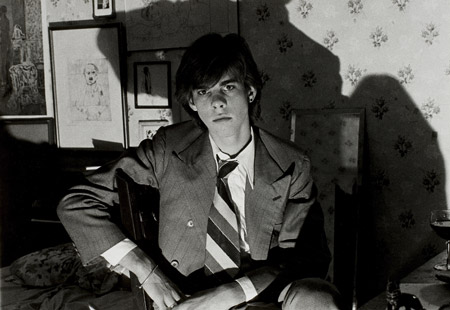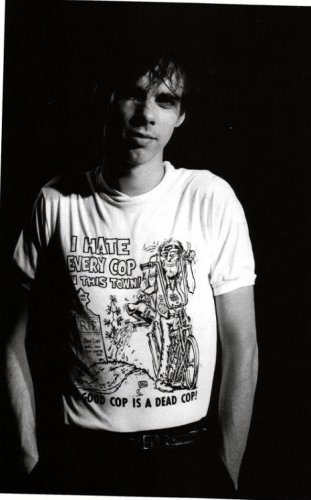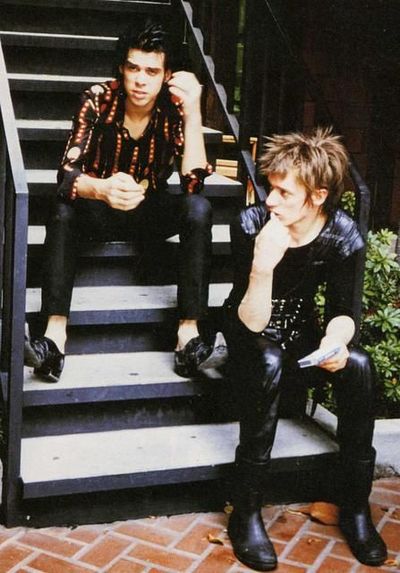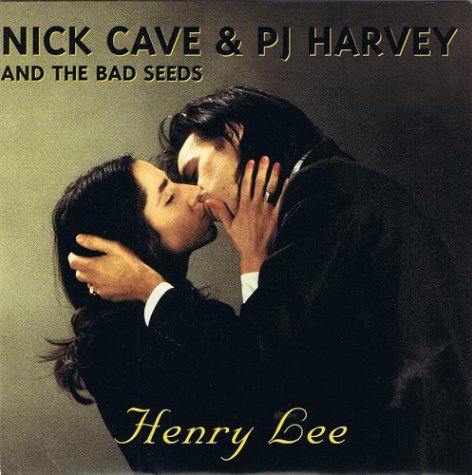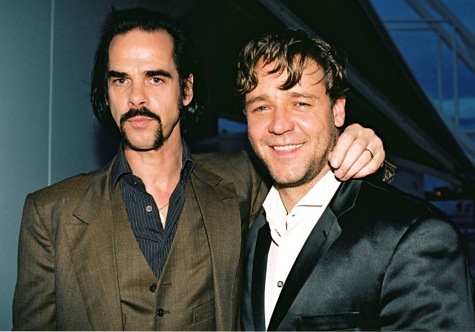|
Nick Cave, Style IconNick Cave is an Australian singer/songwriter. Together with the Bad Seeds Although his style sometimes teeters on the edge of self-caricature, Cave is one of the few adults who can pull of a gothic style without looking like an overgrown adolescent. In point of fact, he's a little scary, even now. Nick Cave's style has changed over the years; what follows is a brief survey of his evolving fashion sense, as revealed through photographs and interviews. Life at School
Nick Cave joined his first band, The Boys Next Door Photos from that time show Cave wearing three-piece suits, or a dress shirt with a tie and slacks. Often his shirts, or suit jackets, are pulled up to his elbows. His hair is short and layered, with the longest hair coming just down to his ears. The other band members wore similar outfits and hairstyles. In one video, taken when Cave was 20 or 21, he wears a suit (although the pants and jacket are different colors) with a polka-dot waistcoat and a bow tie: Nick Cave dropped out of art school after two years; he grew increasingly self-destructive and ran into trouble with the law. By age 21 he was shooting both heroin and speed. Shortly after he dropped out, his father died in a car crash. He would later describe his father's death as a "traumatic experience...that left the hole for God to fill," going on to quote W.H. Auden: The so-called traumatic experience is not an accident, but the opportunity for which the child has been patiently waiting. Had it not occurred, it would have found another, in order that its life become a serious matter.In the moment, Cave dealt with his grief by shutting down. Some time soon afterwards, his band changed their name to the Birthday Party and they left Australia for London. The Birthday Party
The Birthday Party was never a smash hit; their music was too confrontational, too violent, for that to happen. However, the band found their niche in West Berlin, where their aggressive, post-punk sound reached an appreciative audience. It was during this period that Cave's psycho-mullet (for lack of a better word) first appeared. Pictures and films from this time show a young, handsome man, with greasy hair rising wildly above his head, sometimes at unnatural looking angles. Cave's hair is not naturally black; he started dying it as a teenager, and never stopped (yet). This hairstyle, contrasted with his pale skin, only added to his image as a sort of Beelzebub incarnate, especially when juxtaposed with very worn-out (but well-fitting) suits, as in the video below: Pictures from this time show Cave wearing multiple large rings on his hands, t-shirts and very tight jeans (usually with a belt), or the odd suit with a frilly red or white shirt. He wore black winkle pickers in all the photographs I could find that show his feet. The "I Hate Every Cop In This Town!" shirt, pictured above, was drawn by Ed "Big Daddy" Roth, artist of "Rat Fink" and the Birthday Party's second album cover. Cave ran into problems with the law ever since his teenage years; these problems continued into his adult life. The Birthday Party broke up in 1983, after recording three studio albums. Nick Cave and Mick Harvey stayed together for their next major project, Nick Cave and the Bad Seeds. The Bad Seeds
From 1983 to about 1988, Nick Cave lived and worked in West Berlin. This was a period of intense creativity, as well as intense personal trouble, for him. His long-term relationship with Anita Lane collapsed; his drug use continued; he was turned out of his flat, at a low point, when he resorted to dealing heroin. Despite these interpersonal problems, he managed to record four albums, and publish his first novel, And the Ass Saw the Angel Cave also collaborated with other artists, like Die Haut and Lydia Lunch. In the mid-1980s, Cave acted in a few films, notably playing himself in Wim Wenders's Wings of Desire and playing a prisoner in John Hillcoat's Ghosts...of the Civil Dead It was around this time that Nick Cave began to wear dress shirts with colorful, usually abstract printed patterns, some of which were cut out and sewed from his girlfriend's old dresses. As the 80s progressed, he ditched the "psycho mullet" for a more slicked-back mullet, with his hair combed away from his forehead. Cave also adopted the "mafia ring" as it's known in the U.S.: a large, metal ring, with a large gem or stone in its middle, usually worn on the pinkie (as he wore it then). Although it may hold some other significance across (either) pond, not many men can pull it off, especially when paired with a pin-striped, three-piece suit and pointed toe boots. The Road To God Knows Where In 1988, Nick Cave moved to Sao Paolo, Brazil, marking another stage in his creative life, and presumably his personal life as well. 1990s
The 1990s began on a new note––semi-literally––with the release of The Good Son, a more contemplative, slower-paced album, influenced by Cave's move to Brazil and the birth of his son. Though some critics found "New Testament" Nick Cave to be too soft, others saw this album as a mark of his growing artistic maturity. This maturity included a different on-stage aesthetic, one with more white clothes, fewer t-shirts, and subtler belts. There was no sea change, though; we see him wearing the same three-piece suits, albeit better maintained ones, with more or less the same haircut he wore in the late 1980s. A few outfits stand out: in one video from 1996, Cave wears a pink "Take That!" t-shirt with white jeans and pointed-toe, crocodile boots. This video is for a song about a serial killer named Stagger Lee. Somehow pink is appropriate. It was during this decade that Cave began to get off drugs. Reports conflict as to when and how this happened. His youthful features suggests an ongoing struggle. Until about 1997, he was in a relationship with Viviane Carneiro, a Brazilian fashion designer and the mother of his son, Luke. This relative stability may have attenuated his addiction, if not ended it. In 1997, his relationship with Carneiro collapsed. Shortly thereafter, Cave began a relationship with P.J. Harvey, which ended the same year. These two events provided the inspiration for The Boatman's Call, an album-length elegy to lost love. This album is widely considered his magnum opus; the aggression of "Old Testament" Nick Cave is still there, although attenuated and sublimated into a sort of sublime sadness. After P.J. Harvey broke up with him, Cave began a relationship with Susie Bick, then a model for Vivienne Westwood. They married in 1999; Bick had twins two years later. They are still together as of this writing (February 2010). 2000s
As Cave's personal life calmed down, his wardrobe became more conservative––in public, anyway. In almost every photo from the 2000s, Cave is wearing some kind of three piece suit, with or without a tie. Recent photos show him wearing dark (though not black) three-piece suits with a crisp white shirt, its top buttons undone, revealing a bit of his chest. Sad to say, Cave began losing his hair a few years ago. He responded by growing a handlebar mustache and starting a group, Grinderman, which put out an album of aggressive anthems railing against sexual frustration. His second novel, The Death of Bunny Munro ConclusionsNick Cave has a slender, somewhat muscular build; he chooses clothing which accentuates his body type and height. When he was young, his outfits tended to draw attention towards his best features, namely, his narrow waist, youthful face and well-developed upper arms. Cave is also handsome, which allows him more sartorial latitude than most people. Despite this, and despite changes in location, lifestyle and age, his style has remained fairly constant throughout his lifetime. The suit, the leather shoes, and the long black hair have remained from his adolescence to the present day. Cave's formal, somewhat gothic style has never fit into one subcultural category. One doesn't look at him and label him "punk" or "no wave" or "goth," although he incorporates elements of all these styles in both his repertoire and his wardrobe. He may not be the most innovative stylist ever, but everything about Cave's appearance reflects his individuality and his personality, without any apparent effort on his part. He neither tries too hard nor slacks off. This is what makes him a style icon. Related Reading: References: Nick Cave Wikipedia article (and references for that article, listed here) The Secret Life of the Love Song, by Nick Cave. The New Romantic, by Ginny Dougary. The Times, March 27 1999. Return to Enjoy Your Style's icons page. Return to Enjoy Your Style's home page. Search this website: |





